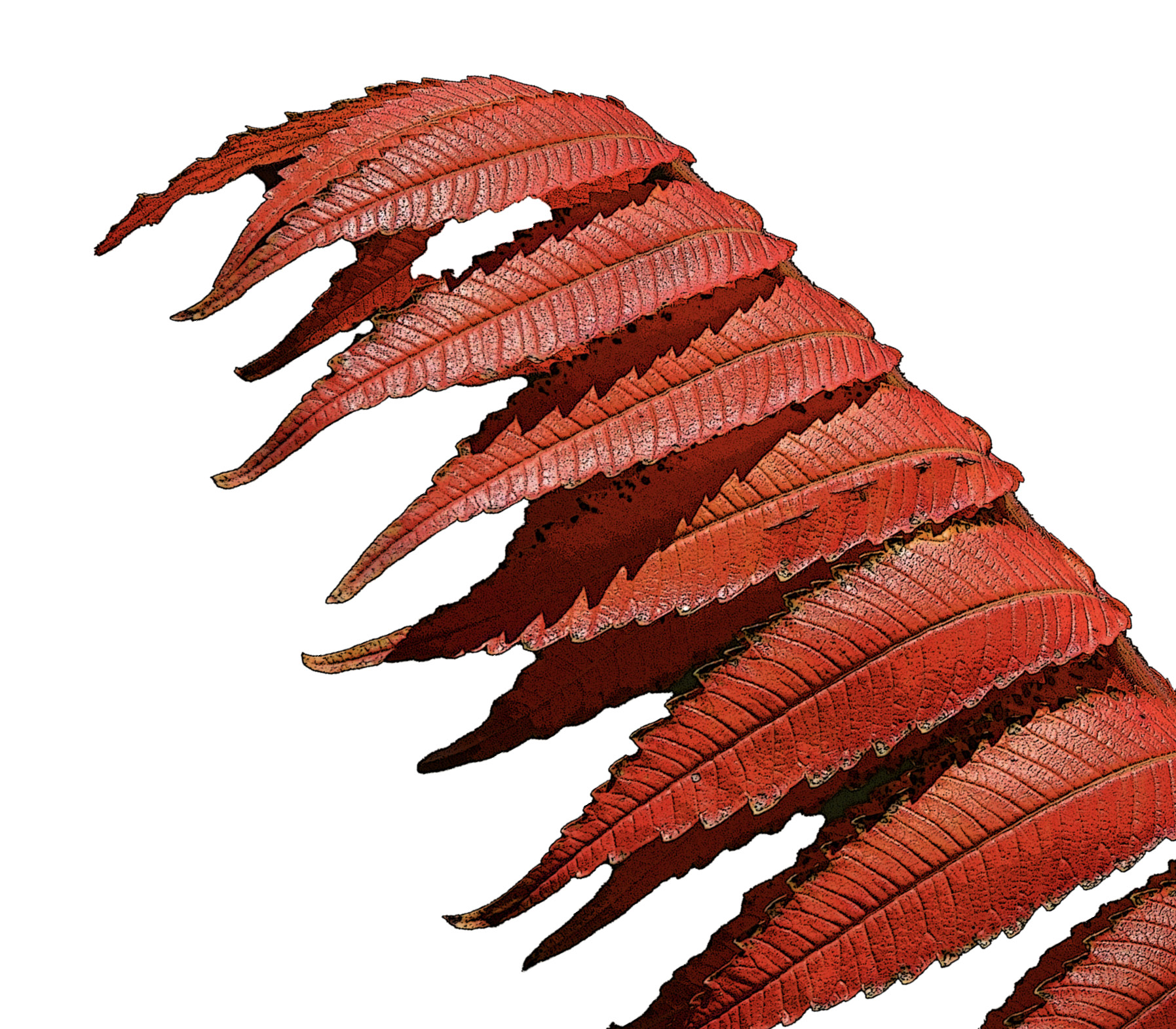
Cole Swanson
Among the Drupes
(Elegy for a Wasteland)

ABSTRACT
Among the Drupes (Elegy for a Wasteland) is an exhibition in communion with The West Toronto Railpath, an emergent ecology at the edge of ruin. Over eight months, I came to know the last remaining grove of staghorn sumacs (Rhus typhina) and their creaturely kin through foraging for and preparation of pigments. In this essay, I interrogate the biopolitics of the Railpath as a site of ongoing forms of displacement, producing mutualisms between Indigenous, queer and marginalised peoples alongside fated more-than-human others. Through harvesting lively colours, I demonstrate flows between ecological agents that antagonise divides between species and their dooming imaginaries. I draw connections between material art practice and forensic-ecology toward environmental justice for eco-assemblages marked for death by settler-colonial hegemonies. Finally, I demonstrate how art can aid us in bearing witness and, through acts of creative and community-based recuperation, provides hope in times of ecosocial grief.
Keywords
environmental justice, staghorn sumac, multispecies art, natural pigments, urban ecology.
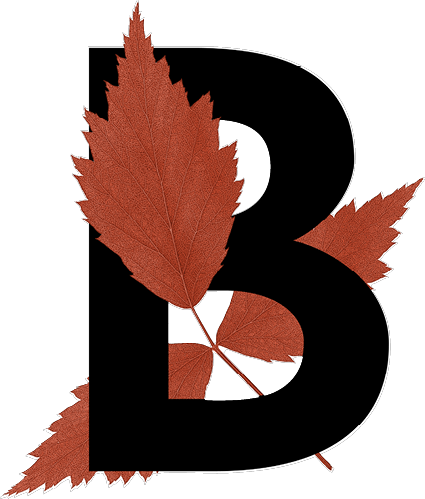 oughs of serrated leaves flutter overhead as I stand in the shade of the last remaining grove of staghorn sumacs (Rhus typhina) on the West Toronto Railpath (Figure 1). I listen to calls of blackbirds, blue jays, cardinals and chickadees, but only a lone mockingbird (Mimos polyglottos) can be spotted nearby. A pair of soiled white jeans dangles low on a branch, casting its shadow on dirty tissues that litter the ground below. The smell of semen fills the air, wafting from a stand of swaying trees.1 A low rumble advances to a scream; the double-decker GO Train passes in furious flashes of green and white. It rattles the acrylic and steel noise barrier that separates the rails from the path. The shuddering walls are illuminated by a boundless gallery of graffiti. After the dust settles, I walk in knotty loops and arcs around the sumacs, inspecting this season’s fuzzy red drupes – the fruits of female plants – and search for saplings not yet razed by municipal workers or strangled by herbicide. Two chatty humans and a dog walk by. Only the canine seems to notice me.
oughs of serrated leaves flutter overhead as I stand in the shade of the last remaining grove of staghorn sumacs (Rhus typhina) on the West Toronto Railpath (Figure 1). I listen to calls of blackbirds, blue jays, cardinals and chickadees, but only a lone mockingbird (Mimos polyglottos) can be spotted nearby. A pair of soiled white jeans dangles low on a branch, casting its shadow on dirty tissues that litter the ground below. The smell of semen fills the air, wafting from a stand of swaying trees.1 A low rumble advances to a scream; the double-decker GO Train passes in furious flashes of green and white. It rattles the acrylic and steel noise barrier that separates the rails from the path. The shuddering walls are illuminated by a boundless gallery of graffiti. After the dust settles, I walk in knotty loops and arcs around the sumacs, inspecting this season’s fuzzy red drupes – the fruits of female plants – and search for saplings not yet razed by municipal workers or strangled by herbicide. Two chatty humans and a dog walk by. Only the canine seems to notice me.
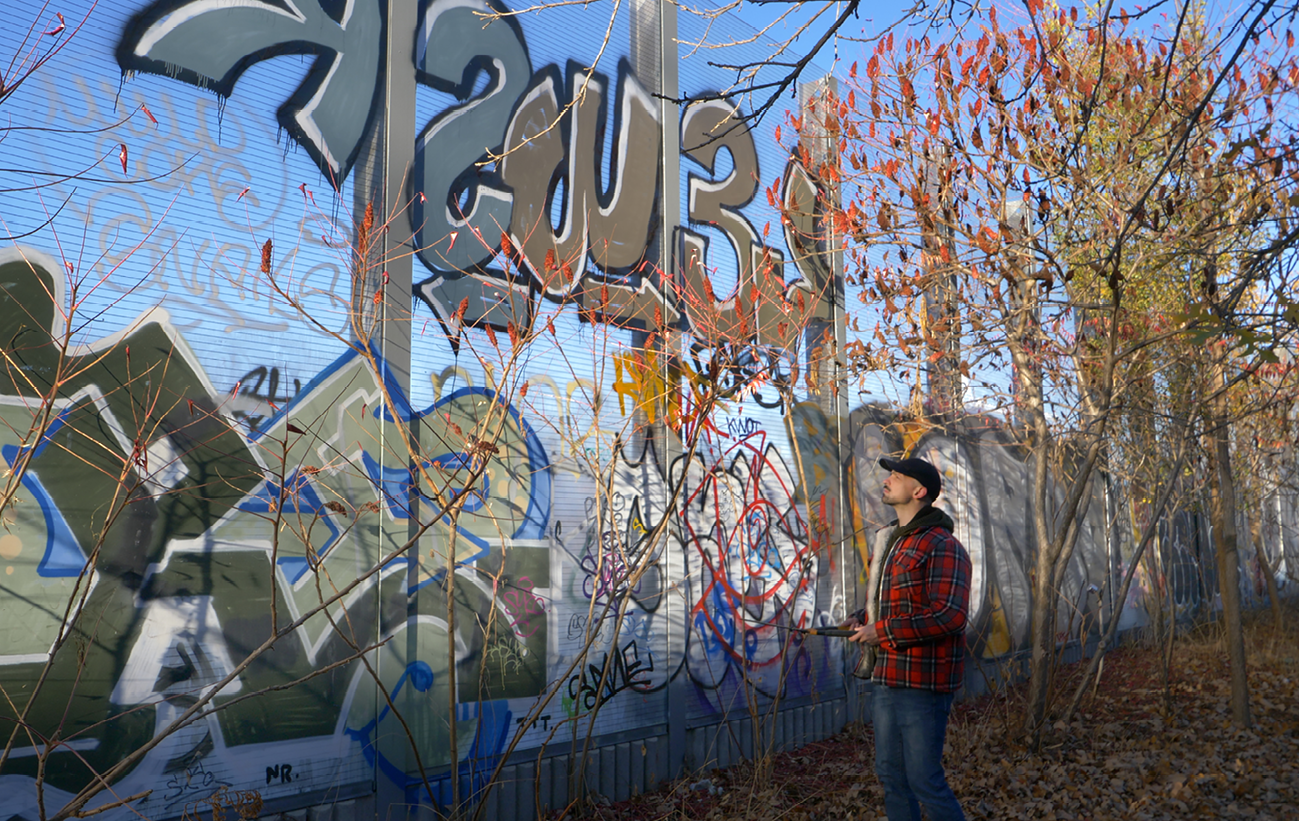
Figure 1.
Staghorn Sumacs on the West Toronto Railpath. 2022. Digital photograph. Toronto, Ontario.
Source: Author.
It is late June, and I am back at the grove where I spent eight months building a relationship with a place at the edge of ecological ruin. The wilderness-turned-footpath was recently carved up to make way for a new commuter rail line (‘Another Round’, 2022). Entire stretches of the formerly ‘rejuvenated’ 2 lands were reduced once more to gravel and dust. A few remaining trees were colour-marked in neon greens and pinks for keeping or killing, but the small cluster of staghorn sumacs remained in place for now, though peaked and wilted. It is unclear how much longer the state will leave them before another wave of ‘green’ and ‘wild’ revitalization comes crashing in (‘West Toronto Railpath Extension’, 2023).
Forty kilometres away, tucked in the historic centre of one of Canada’s fastest growing suburban cities, the Varley Art Gallery of Markham contains my exhibition Among the Drupes (Elegy for a Wasteland). 3 Less than a week before its opening reception, the gallery pulses with the forms and frequencies of the far-away Railpath and its crumbling liveliness.
On first impression, the exhibition feels uncanny and familiar. Visitors are greeted with a single botanical sketch by Frederick H. Varley punctuating the scarlet glow of a jewel-toned wall. The drawing is dwarfed by the monitor next to it, which flashes urban landscape and wildlife sequences (Figure 2). A display cabinet sits to the left of the entrance; it contains vegetal and mineral samples, field studies, watercolours and anthotype prints.4 The room is practically Victorian, charged with the energies of colonial and natural history. Business as usual.

Figure 2.
Among the Drupes (Elegy for a Wasteland), Installation view, The West
Toronto Railpath. video (08:06). 2023 (right); F.H. Varley, ‘Flower of the Staghorn Sumach’. n.d. Charcoal on paper. 25.0cm x 9.4cm. Collection of the Varley Art Gallery of Markham (left). Varley Art Gallery of Markham. Source: Toni Hafkensheid, courtesy of Anik Glaude and the Varley Art Gallery of Markham.
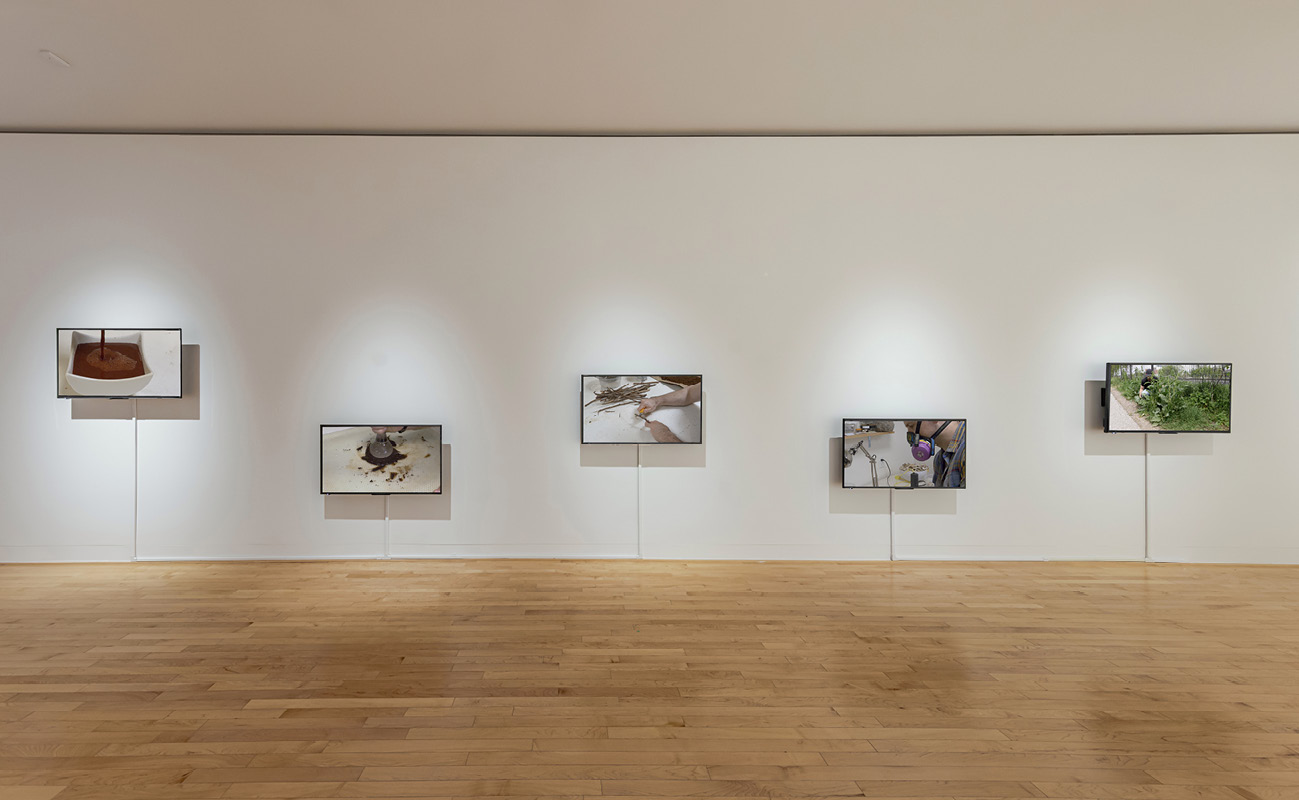
Figure 3.
Among the Drupes (Elegy for a Wasteland), Installation view, video. 2023. Varley Art Gallery of Markham. (left to right):
1. Rhus typhina; Parthenocissus quinquefolia (04:21)
2. Goethite; Coffea arabica(?) (05:03)
3. Rhus typhina carbones (02:03)
4. Cepaea nemoralis (02:23)
5. Rumex crispus (02:20)
Source: Toni Hafkensheid, courtesy of Anik Glaude and the Varley Art Gallery of Markham.
But bypassing the curiosities and didactic panels, visitors encounter five video monitors unevenly plotted on a long, white wall (Figure 3). The installation begins to go feral. The first monitor hangs higher than the rest and two others sink toward the floor. Each video begins with a blackened screen. Slowly, in a walking fashion, white letters appear and disappear from left to right. A patient and attentive viewer might make out taxonomical or scientific designations. P-a-r-t-h-e-n-o-c-i-s-s-u-s q-u-i-n-q-u-e-f-o-l-i-a… G-o-e-t-h-i-t-e… R-u-m-e-x c-r-i-s-p-u-s… In total, seven video sequences reveal seven material processes. Bound to one or more ecological agents from the West Toronto Railpath, each short film figures the transformation of natural matter into artistic media. On the uppermost monitor, my hand reaches high to pick berries from sumac branches. On a low screen, I am seen crouching to gather piles of yellow and brown earth. Autumn sequences give way to winter, spring and summer. There is an orderly affect to the wonky design in which the communion between human and pigmented actors is materialised in installation strategies and seasonal shifts, but also in the bodies of viewers who adjust their gazes to participate, through aesthetic empathy, with the ritual foraging and rendering of art materials. Creeping past the red partition that obscures the back of the room, an enormous mural emerges (Figure 4): branches reach out through graffitied walls; painted leaves melt in liquid lines and sumac drupes bleed toward the floor; the air is rich with the scent of earth and sour fruit; bells clang; the rushing of a train invades the room, and the silence that briefly follows is split open again by the trickster song of the mockingbird.
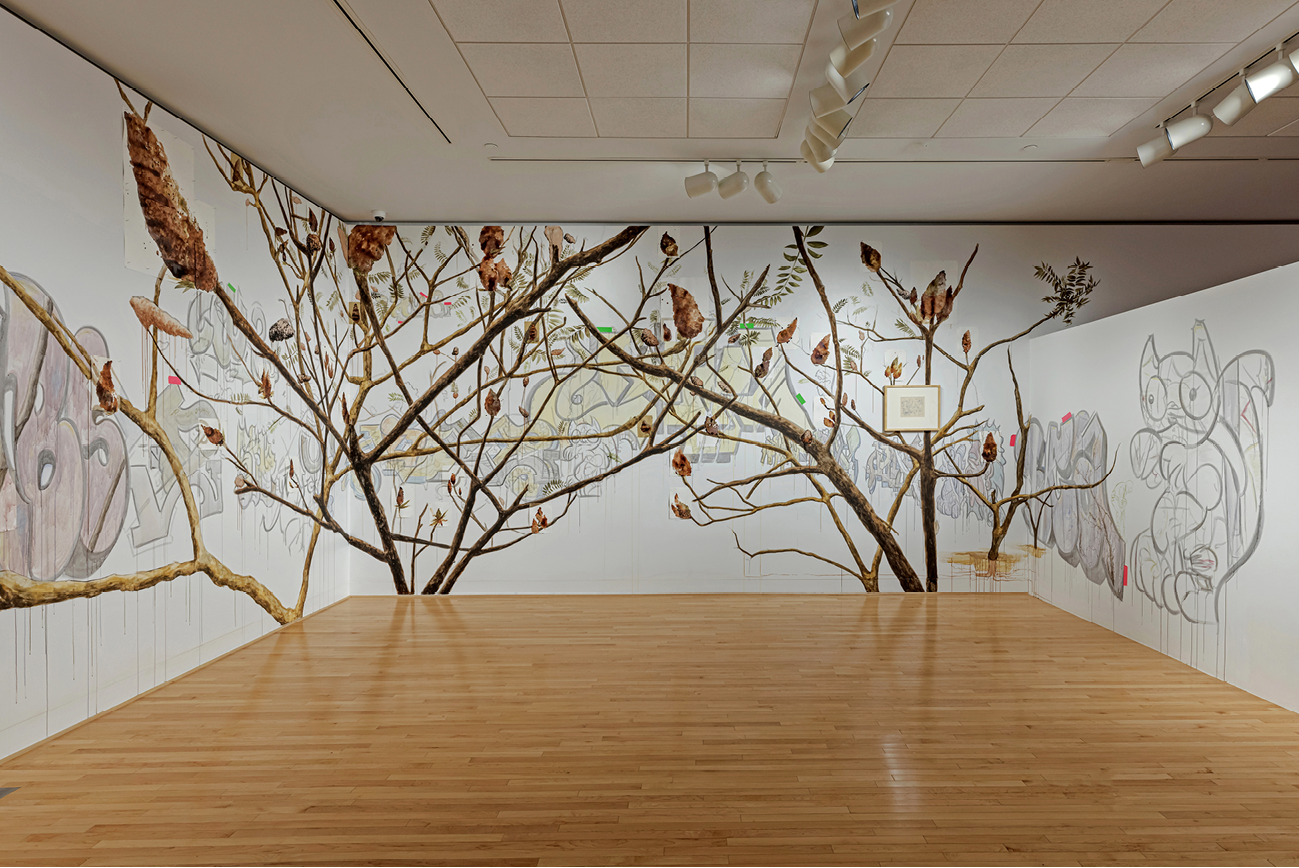
Figure 4.
Among the Drupes (Elegy for a Wasteland), Installation view. Mixed-media installation. Varley Art Gallery of Markham. 2023.
Source: Toni Hafkensheid, courtesy of Anik Glaude and the Varley Art Gallery of Markham.
As the subject for my art exhibition Among the Drupes (Elegy for a Wasteland), the grove of sumacs and their companion species tell messy tales of settler-colonial violence and capitalist ambitions, and of the ecocide wrought by strict loyalties to particular worldviews over more ethical alternatives. But it also flourishes in precarious times through acts of community care and reciprocity that make an awkward ecology into a multispecies home. In this essay, I demonstrate how my material-creative process binds biotic and abiotic assemblages to emergent forms and concepts within multispecies studies and its scholarly companions. First, I will interrogate the biopolitics of the West Toronto Railpath as a site of multiple histories of displacement and violence, which has produced mutualisms between Indigenous, queer and marginalised peoples with fated multispecies others. Through the ethical harvesting and preparation of pigments made in communion with lively and sedimentary actors, I will demonstrate the flows between organisms and unseen partners to antagonise normative divides between species and their dooming imaginaries. Taking up a forensic ecological approach grounded in material-art processes, I will explore the prospects of environmental justice for lively assemblages marked for death by settler-colonial and Western-scientific hegemonies. Finally, I will consider how art can aid us in bearing witness to the suffering of others, and through acts of creative and community-based recuperation, provides opportunities for hope in times of ecosocial grief.
Contexts of creation and destruction
In October 2022, I was approached by Anik Glaude, curator of the Varley Art Gallery of Markham, to produce an exhibition responding to the museum’s new collection of botanical sketches by Group of Seven founding artist and gallery namesake Frederick Horseman Varley.5 Among the dozens of vegetal illustrations scrawled from the field, four humble drawings of staghorn sumac caught my attention. It was not for their artistic genius that I settled on these works (though each does have its moments); rather, only days before, I was stopped dead in my tracks by a grove of flaming red sumacs during a walk home on the West Toronto Railpath. Unlike Varley’s drawings, which were sketched in achromatic lines, isolated from their environments and floating on empty pages, the sumacs along the Railpath were set ablaze in the autumn air among a tangle of (mostly unloved) creatures, dramatically staged against a lavish curtain of graffiti.
Metrolinx, an agency of the Government of Ontario, had already announced plans to expand rail lines into the borders of the Railpath (‘Another Round’, 2022). Signs of the transformations to come were everywhere; trees were fatefully marked with fluorescent paint, wooden stakes staged incoming construction (and destruction) zones and official signage exclaimed DANGER! along the trail’s fencing in equal measures. Large ‘trash trees’ 6 – mainly white mulberry (Morus alba) and Tree of Heaven (Ailanthas altissima) – were the first to go. 7 Their angular stumps numbered in the hundreds along the newly barren path. It became clear that I was a participant-observer in the ‘death zone’ (Rose 2013), a place where the ethical call to bear witness is made by those who are marked with fatality. But resisting the pall cast over the Railpath, the grove of sumacs became flickering beacons of the sort that Karin Bolender (2014) says ‘shine forth to carry cracked hopes through the black wind of terrible times’ (70). The brilliance and vulnerability of the plants catalysed the creation of my multispecies exhibition, which was situated at the intersection of competing political and ecological forces, and where the possibilities for relationality, care, grief and accountability would be found.
(Un)settling the railpath
The story of the West Toronto Railpath occurs over multiple temporalities, comprising narratives embedded in deep time and waves of displacement born of settler-colonial and capitalist incursions. A history told by the Friends of the West Toronto Railpath (FWTR) – the community group behind the transformation of the corridor – begins 14,000 years ago with a fleeting nod to melting glaciers and the First Nations peoples who established trade routes along the Davenport shoreline, the area adjacent to the north of the path (‘History’, n.d.). Jumping millennia, readers are introduced to the local volunteer organisation and their efforts to transform the ‘derelict’ and ‘little-used’ plot into a ‘rails-to-trails’ community space (Ibid.). The tidy timeline connecting ‘ancient’ Indigenous history to the rapidly gentrifying neighbourhoods of the modern Railpath exemplifies a colonial programme that simultaneously capitalises on and erases Indigenous peoples’ relations to the land (Whyte 2022: 135). While a comprehensive history of Indigenous settlement and stewardship is beyond the scope of this essay,8 a consideration of ongoing settler-colonial occupation, scientific ordering and management of the land and its constituents is key to understanding the biopolitical forces that determine who flourishes and perishes (human and more-than-human), and who is imbricated with the colonial violence of the past, present and future.
The neighbourhoods bordered by the West Toronto Railpath are known as The Junction and The Junction Triangle. Long-time resident Leslie Kern (2022: 12) writes that, for decades, these decommissioned industrial zones experienced higher-than-average rates of pollution, homelessness, drug use and sex work. A colossal wave of gentrification hit in the mid 2000s and the imposition of new wealth exiled working-class migrants and people experiencing homelessness, mental illness and disability from the area (Kern 2022: 12). In their absence, streets were scrubbed clean of their ‘porn shops’ and vacant lots, and filled in with ‘hip’ and ‘wholesome’ places for family-friendly fun (Kaminer 2009). The simultaneous transformations of the Junction Region and the West Toronto Railpath are duly implicated in multiple forms of displacement as late-settler systems exorcised the lands of the human and more-than-human bodies who might desecrate urban utopic visions.
Queer scholars offer intersectional perspectives on the politics and materialities of gentrification, linking forms of sexual and social oppression to the broader dimensions of the ecosocial. Prior to its formal establishment, The West Toronto Railpath was a popular cruising area for gay men to meet among the weeds and rubble; however, with gentrification came the attempted cleansing of both queer and ecological forms of so-called deviance.9 Beyond the more obvious heteronormative schemes at play, whereby acceptable conceptions of growth and sociality are bound to the white, straight nuclear family, Neel Ahuja (2015) introduces the dimensions of a queer reproduction, where entangled relations are formed between multispecies agents who are mutually implicated in cycles of wastefulness, violence, dispossession and ecocide. Ahuja (2015) states ‘that neoliberal subjects (including queer subjects) are engulfed by processes linking the reproduction of the ordinary and the extermination of various life forms and forms of life’. (367). In their examination of New York City’s celebrated High Line – an initiative that directly inspired the design of the West Toronto Railpath (‘History’, n.d.) – Darren Patrick (2013) critiques ‘gay’ and ‘green’ forms of gentrification rooted in practices of excessive consumption and self-advancement, through which homonormative actors fortify the stranglehold that heteronormative, settler-colonial and capitalist systems have over the divested. Providing a deep interrogation of the queering of/in urban geographies is not my intent, yet these critiques reveal my own imbrication with the social and environmental harms impacting multispecies others from which I directly benefit. As a gay, white, middle-class homeowner living and making art in the Junction Triangle, I am called to reflect upon the possibilities of the ‘gentrifying parasite’, a settler who, through his own passive flourishing, ‘renders the colonized displaced, disposable, pestilent’ (Ahuja 2015: 367).
The trouble with going native
Staghorn sumac was not intentionally planted throughout the West Toronto Railpath but, after careening trains dispersed its seeds along the trail, it became a welcome addition to the list of native species integrated into FWTR’s ‘award-winning’ eco-restoration plan (‘Stewardship’, n.d.). For the 3.5-million-dollar redesign, volunteers collected seeds from native species found in the urban wilderness pre-dating the Railpath and curated them into four ecological zones (‘Stewardship’, n.d.). Other than the humble seedbank, nearly all other growth was levelled to make way for the new trail (‘Construction gallery’, n.d.). After the path was re-planted in 2009, a three-year incubation period elapsed before the FWTR Environmental Stewardship Plan was established; community volunteers were recruited to help smooth the wrinkles in the rewilding operation, which included manually extracting invasive ruderal species like dog-strangling vine (Cynanchum rossicum), and attending to damage from overzealous mowing by City of Toronto landscapers (‘West Toronto Railpath Environmental’, 2017). As Metrolinx’s expansion project thrust onto the Railpath, community-volunteer, municipal and provincial agencies became oppositional parties in the ecological (mis)management of the space.
The urban-environmental rejuvenation strategies that materialised the West Toronto Railpath embody settler-colonial worldviews that uphold persistent divides between human/inhuman, subject/object, and native/invasive. In dualisms, lively actors find themselves isolated and mobilised toward heightened possibilities of living and dying. In truth, the Railpath staghorn sumacs are knotted up in multispecies worlds where the protections of nativist regimes are illusory at best.10
‘To be a wilderness,’ William Cronon (1996) writes, is ‘to be deserted, savage, desolate, barren – in short, a waste’. (8) Bolstered by Enlightenment discourses and Romantic visions, the colonial worldview emancipated white, European men – the so-called ‘human’ – apart from the rest of nature, and called upon them to civilise, order and manage the wild; this was achieved, in part, through the scientific establishment of hierarchies and taxonomical distinctions (Cronon 1996; Hejnol 2017: G92; Lutz 2020). The settler-colonial concept of the ‘human’ is a terrorising force that subjugates ecological others and oppresses persons whose racial, gendered, sexual and embodied identities diminish their humanity (Luciano and Chen 2015, Turner, Spalding and Deur 2020). Following suit, colonial-scientific designations on species – native, non-native, introduced, naturalised and invasive – demarcates the boundaries between acceptable and delinquent forms of nature, the latter of which contributes to an unmanageable and unproductive ecology, a land beyond human subjectivity – a wasteland (Gandy 2022: 89).11 But, despite the ironic dedication to native species by the settler-state, Catriona Sandilands (2022a) asserts that ‘it is crucial for white settlers to come to terms with the fact that the [invasive] plant is a companion species in settler colonialism and that the entangled agencies of plant and human colonization are ongoing’ (38). Decolonisation requires the dismantling of worldviews that render others ‘killable’ (Haraway 2008) and that thrusts the ‘invasive’, the ‘migrant’ and the ‘inhuman’ toward death (Broglio 2022: 88).
In late Spring 2023, Metrolinx crews exposed swaths of land along the Railpath to non-specific chemical herbicide to control the incredible spread of dog-strangling vine (Metrolinx 2023).12 Regardless of species, all vegetal and terra-bound life, including the staghorns, were exposed to the poison. The West Toronto Railpath sumacs teach us that nativist prescriptions are limited in predetermining how or when flourishing and suffering occurs in multispecies life. Perhaps because they thrive in the ditches of highways and rail corridors – the same disturbed spaces colonised by their invasive companions – or because they resist neat vegetal categories situated within taxonomical hierarchies (a small tree? a large bush?), the native sumacs of the Railpath duly suffer alongside their non-native kin, as well as the countless species-assemblages who remain hidden beyond the settler-gaze. Karin Bolender (2014) asks, ‘what do you do when the very use of names and abstractions seems to imply an exclusive authority that undermines our companions’ ways of knowing the world?’ (71) The flourishing that happens in wastelands contains multitudes of such knowledges and, by its very existence, resists colonial mastery predicated on violent forms of atomisation and their attendant strategies to divide and conquer. Moving the dial toward justice therefore requires a refusal of this material-semiotic separation of earthly actors. Donna Haraway (2016a) encourages us to think relationally toward moments of life existing within and between:
The main point is that insofar as biopolitics is concerned, this question of ecosystem assemblages is the name of the game of life on Earth. Period. There is no other game. There are no individuals plus environments. There are only webbed ecosystems made of variously configured, historically dynamic contact zones (249–50).
Reflecting within this thorny place, I worked through a creative process to make sense of the corporeal and psychic injustices among the drupes and sat in elegiacal repose in the vital space that bonds wayward kin.
Colour, attunement and forensic relations
On a dry, winter day,
walk the fence-line among the stumps.
Fix your eyes on barren patches of poisoned earth to find the shells.
White ones are safe to take.
Brown ones need to be checked:
hollow ones, go into the basket;
sealed ones, go to the trunks of healthy trees,
nestled into the ground and blanketed with dead leaves to become warm again.
In the studio, bathe the lot in warm water,
rinsing through and through until the fishy scent begins to fade.
Spread thin on cloth, piece by piece,
to rest for three days.
Mask on!
Crush shells, bone dry, by pestle and mortar, and sieve.
Crush again.
Bathe the finest grinds once more
through cloth and into a jar
to rest for three days.
Siphon and let settle,
forming a crust,
and mull with gum, honey, and aromatic clove.
Jar, seal and store.
Snail white,
Cepaea nemoralis.
Creative and intellectual contributions that emerge from artistic processes are often obfuscated by the Western modern obsession with finished products. Substantiated by the galleries where they are shown, resolved pieces embody the artist’s victory over processual challenges; however, forgoing attention to materials and processes erases the knowledge contributions that exist beyond cognitive space toward multisensory dimensions. Instead, art and its processes might be re-imagined as a form of research capable of producing investigative pathways into the present-future impacted by climate change and ecological destruction (Loveless 2019). Based in the studio and in relationality, this work is rigorous, micro-political (bit-by-bit), operates at the local level, and is grounded in advocacy, action and ethics. Such art can establish new ways of thinking and acting in a world disrupted because it already occupies a contested space within research institutions and skirts the parameters and logics of more established disciplines that emerge from within colonial regimes (Loveless 2019). Unearthed through artistic engagements, the knowledge embedded in materials and their preparation emerges from within a web of complex and reciprocal transformations between bodies (human and more-than-human) situated across time and space. Seemingly small encounters between eco-material actors within marginal ecologies contain rich insights into emergent social, cultural, political and environmental conditions. In specific, colours and their preparation can demonstrate the incredible complexity and interconnectivity beyond the boundaries of so-called nature. Given my history of artistic research into the origins and production of pigments, especially those foraged from unruly landscapes, I produced art materials to reveal stories bound-up in the Railpath’s transformations. Focusing only on the sumac grove and its inhabitants, I engaged in a place-based approach to multispecies research that mingled elements of craft, biology, chemistry, and ethnography.
A clandestine encounter between a sumac tree and grove snail spurred my first dalliance with the Railpath’s creaturely colours. Fused with the gastropod’s mucosal flesh, the shrub’s branch offered the mollusc a kindness against the chill of that November morning (Figure 5). Brown-lipped grove snails (Cepaea nemoralis) are branded an invasive European migrant (Maki 2014, ‘Discover the Plants’, n.d.). Given their numbers and ecological status throughout Ontario ecologies, it is unsurprising that thousands of dead snails strewn along barren sections of the Railpath would raise no eyebrows. Grove snails overwinter under leaf litter (Deneif et al. 2021) and, with only the stumps of invasive trees left along much of the Railpath, the snails were next to go.
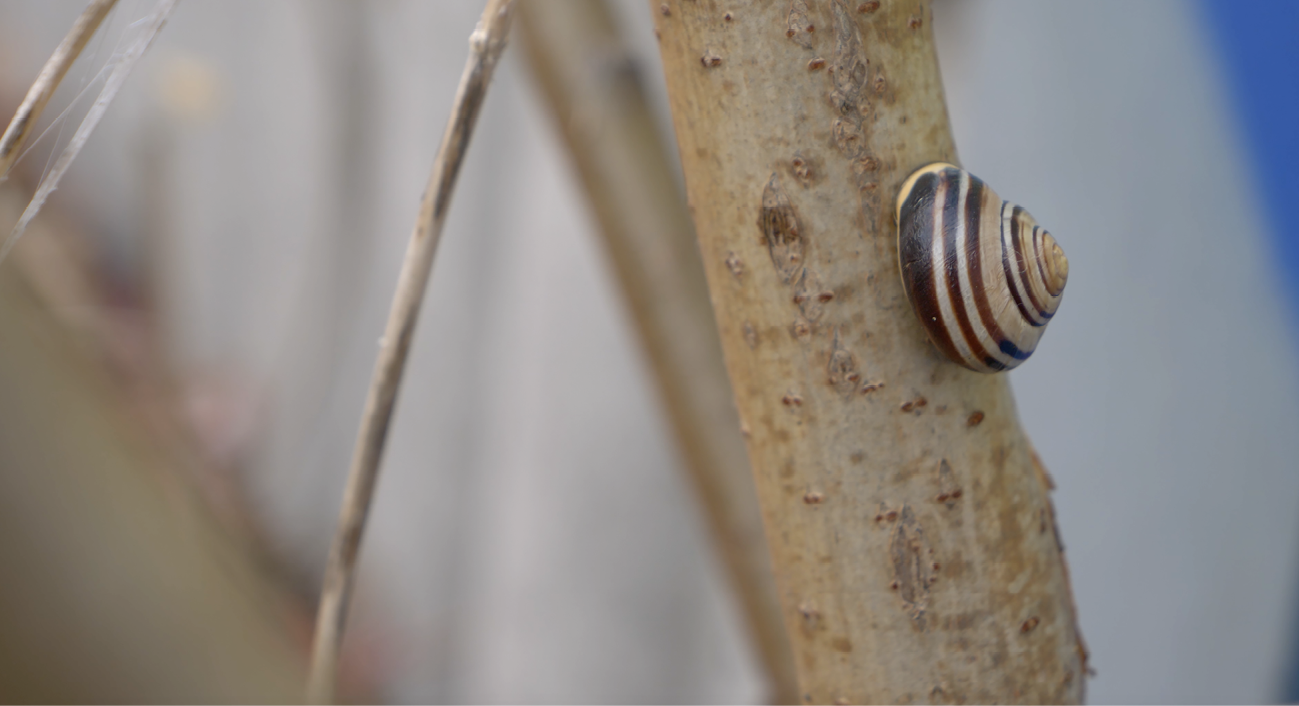
Figure 5.
Brown-lipped Grove Snail on the Branch of a Staghorn Sumac. 2022.
Digital photograph. Toronto, Ontario.
Source: Author.
Unconventional in terms of a pigment-making practice, I collected the shells of expired grove snails to synthesise a colour that might tell us something about the species at large, but more importantly, to embody a record of the manifold relations inscribed within individual, corporeal remains. My process of attending to dead snails is a form of forensic ecology which Joseph Pugliese (2020) might agree pursues justice for ecological entities re-made into enemies of the state:
Ecological justice is what works to bring into focus different entities (soil, water, trees, animals) that, under existing forms of ‘Euro-anthropocentric law, possess no aural life and thus remain outside the purview of justiciability’ … They are not part of the community or society that the legal systems concern themselves with, and have no inherent right to existence or to have a habitat in which to live (33).
In a forensic ecological practice, a deep study of material remains can hold accountable those who deliver death without reprisal or remorse.
It is possible to access elements from the life and suffering of an organism by measuring colour against emergent scientific research on the species. Snail shells contain multiple pigments, both organic (melanins, for example) and inorganic (calcium carbonate, as found in chalk) (Williams 2017). Each pigment has a different level of lightfastness, which translates into fugitive timelines. Following exposure to UV light, organic colours fade more quickly than their inorganic counterparts. Richly coloured shells belonged to snails who have more recently perished than their paler cousins. Time of death can be deduced by colour saturation (van Dooren 2022: 99). The concentration and pattern of a shell’s brown rings is also a record of a snail’s environmental experience and, in particular, their exposure to shifts in light and temperature (Williams 2017: 92). Studies on contaminated habitats suggest that the colour and morphology of shells are also influenced by their absorption of heavy metals (Jordaens et al. 2006). To sum, the paint synthesised from snail-remains along the Railpath contains the life stories of gastropods fighting to survive against environmental disturbance, gentrification, contamination and climate change; but it also contains moments of life shared between snails and other creatures, interspecies poetics too quiet perhaps for humans to notice, or even imagine.
Each of the seven pigments that I produced contains and reveals relational knots that muddy the boundaries between living agents and their settler-coded futures (Figure 6).13 But I confess, as pleasing as it was to prepare seven neatly packaged colours, their apparent commoditisation was dissonant with the spirit of my study. The lively paints and inks demanded release from their jars: to be mixed among one another; to blend, attract and resist each other; to be brought back to life, refusing to be forgotten. From the wasteland colours, a mural emerged as both an explosion and a eulogy.
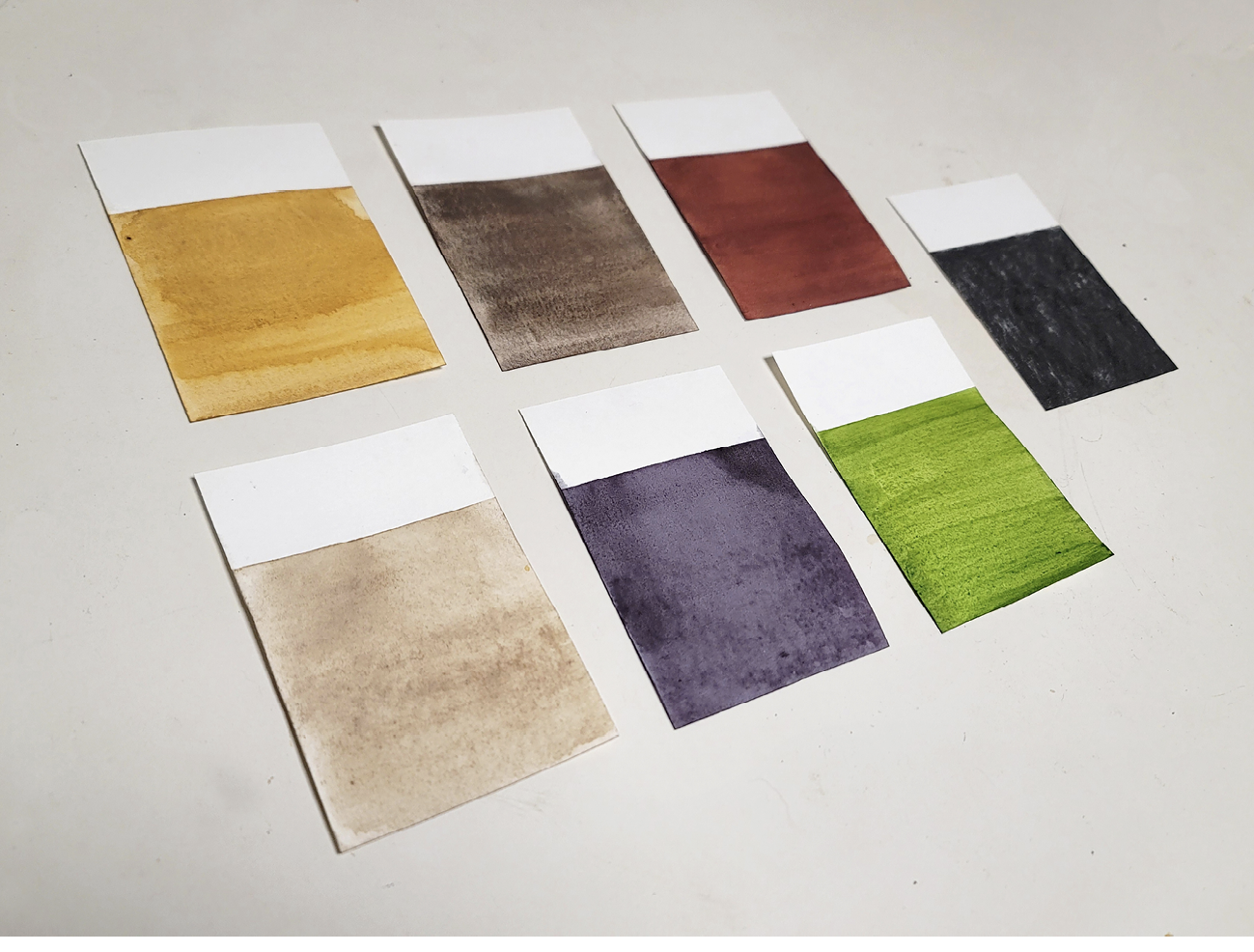
Figure 6.
Pigment Colour Swatches. Foraged and hand-rendered media from the West Toronto Railpath on watercolour paper. 2023.
Source: Author.
Material witness and deviation
‘One of our responsibilities as human people is to find ways to enter into reciprocity with the more-than-human world. We can do it through gratitude, through ceremony, through land stewardship, science, art, and in everyday acts of practical reverence’ (Kimmerer 2015: 190).
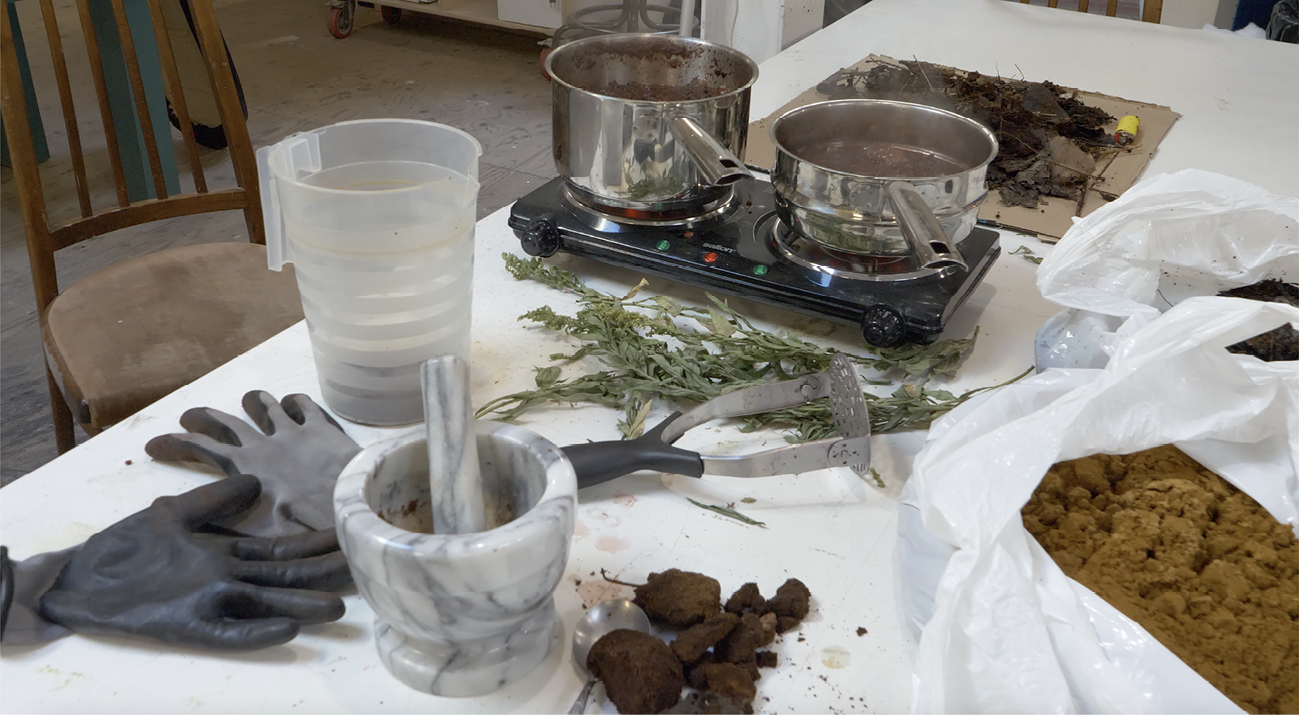
Figure 7.
Material Process Documentation, Among the Drupes (Elegy for a Wasteland). 2023. Digital photograph. Toronto, Ontario.
Source: Author.
From autumn to late spring, my studio was transformed into a laboratory-cum-witch’s-hollow (Figure 7). Cauldrons bubbled to the brim with sanguineous drupes. Fistfuls of yellow soil unearthed by construction crews were washed to separate pigments from sand. Shells were cracked and crushed with the pestle and mortar, and branches were blackened in the fireplace. It took months to prepare enough inks, paint and charcoal to fill the sixty-foot space that housed my mural. Throughout the rigour, I meditated on the possibility that art could help resist the normative tendency to walk on by in the face of non-human suffering. Many multispecies scholars and artists have leaned into advocacy, recognising the problem of killing without care (Despret 2016: 85, Hatley 2017: 31, Kirksey 2015: 218, Kirksey and Helmreich 2010). For Haraway (2016b: 10), reconciliation and restoration must give way to more modest forms of partial recuperation that brings species closer together, while Deborah Bird Rose (2017) compels us to bear witness to suffering and act: ‘The call of those in peril expresses their longing always for connection within the world of life, and so we are doubly responsible – first, we have the responsibility to hear that call, and second, we have the responsibility to respond to it’ (65).
As far I could tell, the barrier to becoming an attentive witness to life on the Railpath is based in its linearity. Human traffic moves through the corridor from point A to point B; all life on the periphery is made invisible by the inwardly focused attention propelling human bodies from one busy place-moment to another. Tim Ingold (2007: 85) affirms that the straight line embodies Western-modern, rationalist strategies for conceptualising, mapping and slicing up lands. But attunement requires penetrating borders of many varieties, infiltrating the spaces where knowledge and relationality converge. Almost every day for eight months, I strayed from the path within the grove, among the graffiti and into the sidelines. The design of my mural refuses the straight line so that gallery goers are likewise compelled into the margins, subsumed into their rich, cosmopolitan queerness.
Appropriately, the graffiti in the grove inspired the first layers of paint. From its graphic foundations, I developed a wayward pictorial structure based in multiple perspectives and temporalities. First, I photographed graffiti tags and characters that rogue artists spray-painted onto the Railpath’s noise barrier. I transferred the images in compound layers across the gallery walls, repeating forms and overlapping contradictory perspectives to expand the viewer’s sense of time and space. The scene loops in on itself. Familiar icons emerge again and again, creating a psychic impression of walking in circles. A cartoon squirrel is repeated three times at different scales and angles (Figure 8). As I painted the wily creatures, I wondered whether the many squirrels of the Railpath had agency in the creation of this charismatic cartoon. I believed that bringing graffiti into the gallery offered a counterpoint to more socially acceptable forms of art within the public realm and the fine art enterprise itself, especially when compared with the Varley sketches that situated the project within the gallery in the first place. When the Railpath was being designed, public art projects were commissioned for permanent installation as state-approved examples of artwork befitting the commons (‘Public Art’, n.d.). But the spontaneous graffiti commands a more powerful presence: it is super-saturated, ephemeral, subversive and unpredictable. Graffiti is the aesthetic kin of invasive species, and the state has haemorrhaged funds trying (and failing) to scrub the Railpath clean of it. (Gupta 2017).14

Figure 8.
Among the Drupes (Elegy for a Wasteland), Installation view. Mixed-media installation. Varley Art Gallery of Markham. 2023; F.H. Varley, ‘Sumachs’. Blue ballpoint pen on paper. 20.1cm x 29.8cm. n.d. Collection of the Varley Art Gallery of Markham.
Source: Toni Hafkensheid, courtesy of Anik Glaude and the Varley Art Gallery of Markham.
Neel Ahuja (2015) recognises that ‘small bodies and intimate environments often get lost in big atmospheric narratives’ (370). I meditated on such oversights while I was painting sumac trees across the gallery walls. I was enchanted by these generous and beautiful plants, whose boughs enveloped me throughout the seasons. For weeks leading to the exhibition, I painted dozens of watercolours on scraps of paper, conjuring sumac drupes of every sort (Figure 9). Their aqueous forms came alive with the mingling of colours whose sources lived within, among and beneath the trees. It was fitting that the long arms of the sumacs, which rose up into the gallery like magnificent antlers, were materialised by the grove’s multispecies palette. Soils, berries, leaves, shells, bark, compost: together they formed the artwork’s material-aesthetic constitution. I painted leaves high up among the branches in fugitive green pigments (chlorophyll); these colours fade first, just as the foliage in the grove will wither and die in the autumn and winter, leaving bare branches and drupes behind. I revived Varley’s sketches upon the walls, re-drawing and re-painting them in sumac-based charcoal and ink. I imagined freeing his plants from their framed and vacant pages, propelling them into the settled and unsettling ecologies of our time. I mounted my paper works across the mural and fixed the drupes into place. Each page was painted seamlessly into the composition. In a final gesture, I included tiny tributes – assemblages and sketches – hidden among branches and in-between spaces, like poems dedicated to those with whom small but impressionable moments were shared. On the day I completed the piece, the Railpath’s sultry smells and techno-biotic sounds filled the room, transcending representation toward a fleshly and felt sense of place: beautiful, restless, mournful.15
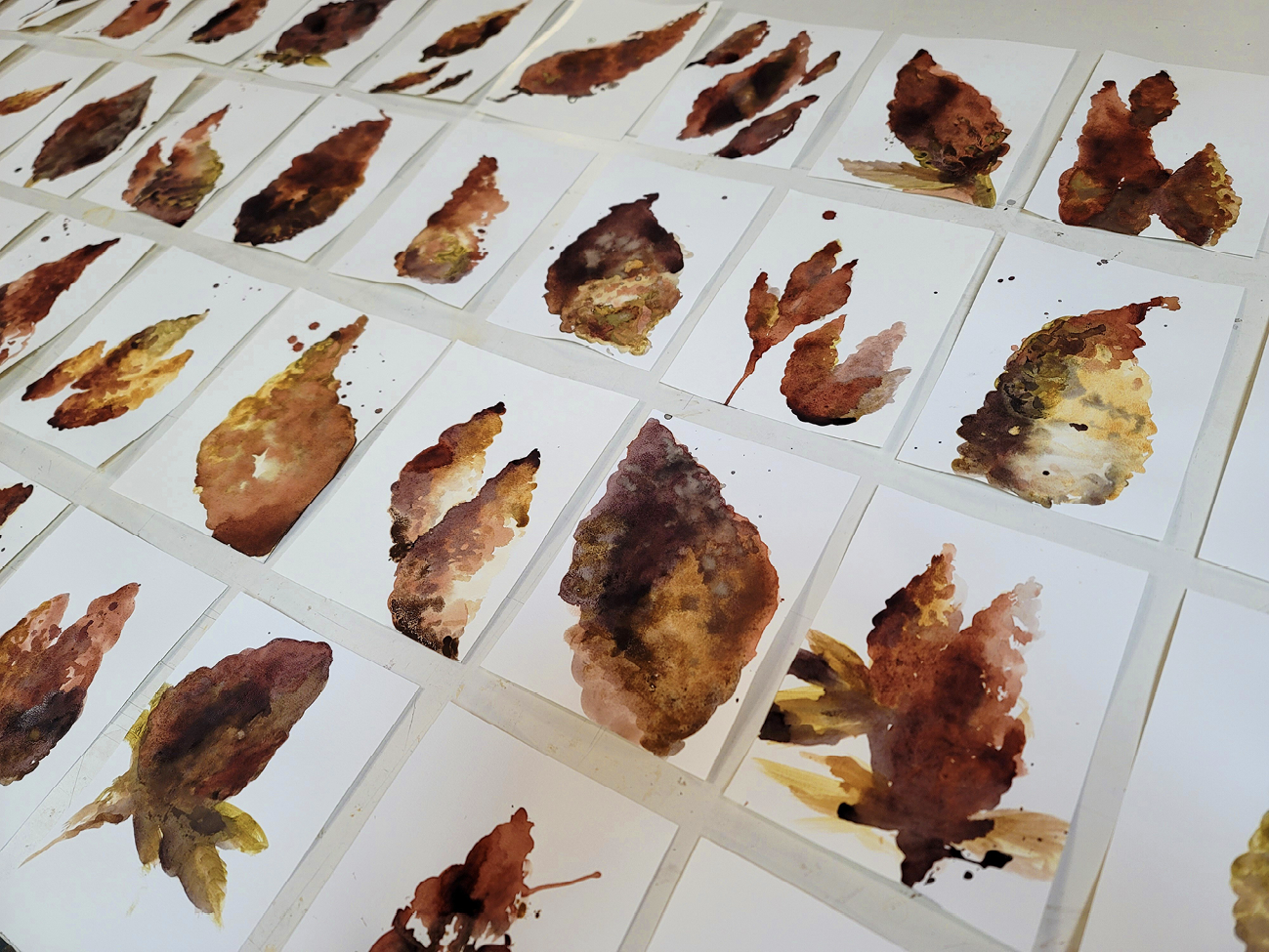
Figure 9.
‘Drupes’. Mixed-media watercolour. 23cm x 30.5cm (collection of 65). 2023.
Source: Author.
Conclusion
[J]ustice is much more common than we tend to think; rather than an unreachable ideal, it is what happens when there is coexistence between disparate worlds that share, for time being or on a more permanent basis, the same physical space. (Marder 2022: 135)
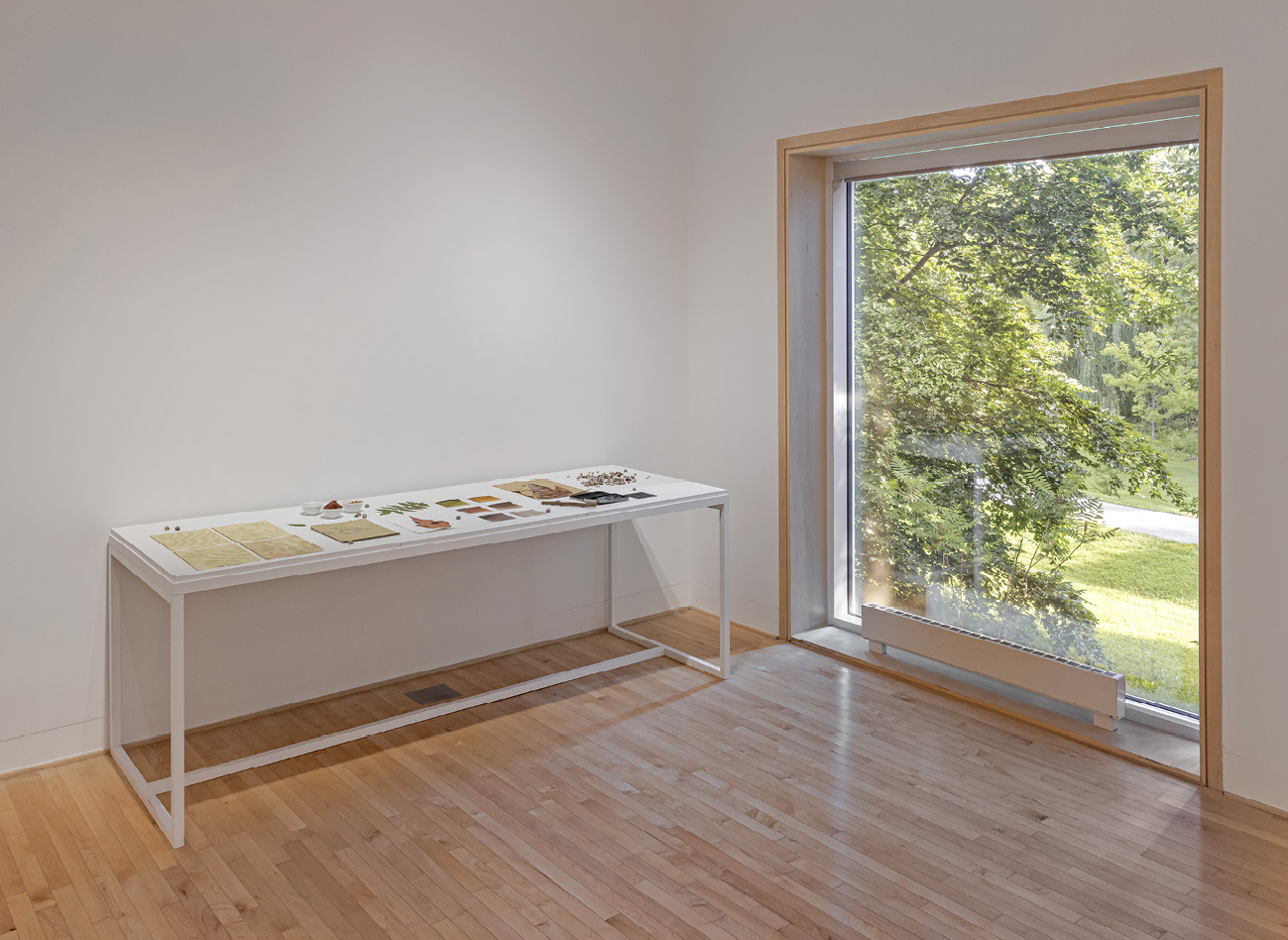
Figure 10.
View of staghorn sumac saplings viewed from Among the
Drupes (Elegy for a Wasteland) alongside a display case of processual materials. 2023.
Source: Toni Hafkensheid, courtesy of Anik Glaude and the Varley Art Gallery of Markham.
A small band of saplings bask in the sun. Their compound leaves gather high in pompom clusters, waving on spindly stalks. A few plants have ruby-red drupes, though miniature in size. Peering through a large window in the gallery holding my exhibition, I check up on the little staghorns who were transplanted from the Railpath onto the museum grounds near Toogood Pond (Figure 10). In early May, when the saplings were barely sticks donning tiny buds, horticulturalist Lynn Short and I went guerrilla gardening.16 Draped in official arboretum attire to deflect unwanted attention, she guided me through the careful work of separating 21 saplings from their rhizomal elders. Gingerly, we spaded them from the ground and pulled the dog-strangling vines from their root-balls. We bagged them bare, leaving behind contaminated soils, keeping them moist for the brief journey between Toronto and Markham. They were planted into four separate plots, the best of which gently sloped in the way that staghorns love. Sumacs are clonal plants, so beyond making ‘conventional’ children, they can reproduce themselves from roots-to-shoots (how queer!). Moving the saplings from the Railpath’s contaminated soils to healthier municipal grounds ferried the ‘original’ plants from harm to relative safety. Anna Tsing (2017) declares that ‘[s]urvivors of contaminated diversity carry with them the history of death and suffering upon which their lives are founded’ (33). We had no assurance that all or any of the saplings would survive. We waited anxiously for sunnier days to wake up the furry buds. As the first leaves emerged, several plants grew and withered, likely from exposure to the previous season’s herbicides. The remaining trees needed special attention – consistent watering by gallery staff, and mulching by City of Markham landscaping crews, who were tickled at the prospect of having staghorn sumacs planted on the grounds.
Urban rewilding projects in Canada often embody histories of displacement and dispossession, of unrequited suffering levelled upon those caught up in regimes of domination. It is difficult work to sight and resist the biopolitical schemes that prescribe who is allowed to flourish and who is marked to die. Indigenous, queer and multispecies scholars, advocates, and elders contribute modes of relationality and care that resist the psychic-material foundations upon which ecosocial and ecocidal terrors are made real. Art can help too, by infiltrating rationalist and commodity regimes, pulling them apart from the inside out to reveal enriched accounts of life and death that otherwise go unnoticed. It can transcend the cognitive toward emotional and multisensory dimensions, building meaning through experiential forms of interconnection which open prospects for deepening our relations with the most unlikely kin.
‘There is no guarantee of better outcomes’, writes Deborah Bird Rose (2022), ‘it is a voice of witness, but not necessarily (indeed often not) a voice of triumph’ (151). When the mural is wiped clean and the exhibition artefacts are packed-up, the work will persist in the fragile flesh of saplings and their material-semiotic futures, which are inescapably bound to the same systems of colonisation and suppression from which they came into form and being. As they grow and sprout clones, expanding their canopy over municipally-controlled lands, will they be met with the same affections as when they were small and vulnerable? How can I reconcile the impossibility of easy flourishing, in healthier soil but on settler ground? How might hope travel with plants and people in ways unseen and unknowable? There is a persistent tension in not-knowing that gives me hope, because not-knowing resists the impulse to close the book on this work and turn away from the communities born of it. Not-knowing draws me back toward the grove, to visit with the elder trees, and to find new ways to grow together, for as long there is still time.
References
Ahuja, Neel. 2015. ‘Intimate atmospheres: queer theory in a time of extinctions’. GLQ 21 (2–3): 365–385.
‘Among the Drupes (Elegy for a Wasteland)’. Varley Art Gallery of Markham: https://www.markham.ca/wps/portal/home/arts/varley-art-gallery/all/previous/01122023-among-the-drupes (accessed 30 August 2023).
‘Another round of work kicks off on the Kitchener Line’. 2022. Metrolinx, 26 July: https://www.metrolinx.com/en/news/another-round-of-work-kicks-off-on-the-kitchener-line-that-will-see-an-upgraded-bloor-go-station-and-west-toronto-railpath (accessed 30 July 2023).
Bolduc, Denise, Mnawaate Gordon-Corbiere, Rebeka Tabobondung and Brian Wright-McLeod. 2021. Indigenous Toronto: Stories That Carry This Place. Toronto, ON: Coach House Books.
Bolender, Karin. 2014. ‘R.A.W assmilk soap’. In E. Kirksey (ed.), The Multispecies Salon, pp.64–86. Durham: Duke University Press.
Broglio, Ron. 2022. Animal Revolution. Minneapolis: University of Minnesota Press.
‘Construction gallery’. Friends of the West Toronto Railpath: https://www.railpath.ca/construction-gallery (accessed 31 July 2023).
Cronon, William. 1996. ‘The trouble with wilderness; or, getting back to the wrong Nature’. Environmental History 1 (1): 7–28.
Denief, Emily E., Julie W. Turner, Christina M. Prokopenko, Alec L. Robitaille and Eric Vander Wal. 2021. ‘At a snail’s pace: The influence of habitat disturbance on terrestrial snail movement using experimentally manipulated mesocosms’. BioRxiv. https://doi.org/10.1101/2021.10.05.463224
Despret, Vinciane. 2016. What Would Animals Say If We Asked the Right Questions? Minneapolis: University of Minnesota Press.
Diamond, Alissa Ujie. 2024. ‘Entangled genealogies: Mulberries, production of racial categories, and land development in Central Virginia’. Plant Perspectives. https://doi.org/10.3197/WHPPP.63845494909743.
‘Discover the plants and animals of Pelee Island’. Nature Conservancy of Canada: https://www.natureconservancy.ca/en/where-we-work/ontario/stories/discover-pelee-island.html (accessed 31 July 2023).
Flanders, Danny. ‘Trash trees: Avoid planting messy, smelly trees’ HGTV: https://www.hgtv.com/outdoors/flowers-and-plants/trees-and-shrubs/trash-trees-avoid-planting-messy-smelly-trees (accessed 26 July 2023).
‘F.H. Varley artwork comes home for the holidays during Group of Seven 100th Anniversary’. 2020. Markham.ca. 15 December: www.markham.ca/wps/portal/home/about/news/sa-news-releases/f-h-varley-artworks-transferred-from-art-gallery-of-ontario-to-varley-art-gallery-in-2020 (accessed 2 July 2023).
Gandy, Matthew. 2022. Natura Urbana: Ecological Constellations in Urban Space. Cambridge, MA: The MIT Press.
Gupta, Rahul. ‘Metrolinx couldn’t entirely remove graffiti on UP Express noise walls’, Toronto.com, 24 January 2017: https://www.toronto.com/news/metrolinx-couldnt-entirely-remove-graffiti-on-up-express-noise-walls/article_b5126431-7b6d-54af-be4f-39628cfe3cf4.html (accessed 26 July 2023).
Haraway, Donna Jeanne. 2016a. Manifestly Haraway. Minneapolis: University of Minnesota Press.
Haraway, Donna Jeanne. 2016b. Staying with the Trouble: Making Kin in the Chthulucene. Durham: Duke University Press.
Haraway, Donna Jeanne. 2008. When Species Meet. Minneapolis; London: University of Minnesota Press.
Hatley, James. 2017. ‘Walking with Ōkami: the large-mouthed pure god’. In Rose, van Dooren and Chrulew (eds), Extinction Studies, pp.19–46.
Hejnol, Andreas. 2017. ‘Ladders, trees, complexity, and other metaphors in evolutionary thinking’. In A. Lowenhaupt Tsing, H.A. Swanson, E. Gan and N. Bubant (eds), Arts of Living on a Damaged Planet: Ghosts and Monsters of the Anthropocene, pp. G87–102. Minneapolis: University of Minnesota Press.
‘History’. Friends of the West Toronto Railpath: https://www.railpath.ca/history (accessed 8 July 2023).
Ihar, Zsuzsanna. 2022. ‘Multispecies mediations in a post-extractive zone’. In S. Chao, K. Bolender and E. Kirksey (eds), The Promise of Multispecies Justice, pp. 205–25. Durham: Duke University Press.
Ingold, Tim. 2007. Lines. London: Routledge.
Jordaens, Kurt, Hans De Wolf, Bart Vandecasteele, Ronny Blust and Thierry Backeljau. 2006. ‘Associations between shell strength, shell morphology and heavy metals in the land snail Cepaea nemoralis (Gastropoda, Helicidae)’. Science of The Total Environment 363 (1–3): 285–93.
Kaminer, Michael. 2009. ‘Skid row to hip in Toronto’. The New York Times, 5 July: https://www.nytimes.com/2009/07/05/travel/05surfacing.html (accessed 25 July 2023).
Kern, Leslie. 2022. Gentrification Is Inevitable and Other Lies. Toronto: Between the Lines.
Kimmerer, Robin Wall. 2015. Braiding Sweetgrass. Minneapolis: Milkweed Editions.
Kirksey, Eben and Stefan Helmreich. 2010. ‘The emergence of multispecies ethnography’. Cultural Anthropology 25 (4): 545–76.
Kirksey, Eben. 2015. Emergent Ecologies. Durham, NC: Duke University Press.
Loveless, Natalie. 2019. ‘Conclusion: Art at the end of the world’. In How to Make Art at the End of the World: A Manifesto for Research-Creation. Durham: Duke University Press.
Luciano, Dana and Mel Y. Chen. 2015. ‘Has the queer ever been human?’ GLQ 21 (2–3): 183–207.
Lutz, John Sutton. 2020. ‘Preparing Eden: Indigenous land use and European settlement on Southern Vancouver Island’. In Turner (ed.), pp. 107–30.
Maki, Christine. 2014. ‘Snail hunters need to get under the hood to spot invasive species’. CBC News, 15 August: https://www.cbc.ca/news/canada/ottawa/snail-hunters-need-to-get-under-the-hood-to-spot-invasive-species-1.2736914 (accessed 20 July 2023).
Marder, Michael. 2022. ‘Justice at the end of worlds’. In S. Chao, K. Bolender and E. Kirksey (eds), The Promise of Multispecies Justice, pp. 125–38. Durham NC: Duke University Press.
McCune, Letitia and Alain Cuerrier. 2020. ‘Traditional plant medicines and the protection of traditional harvesting sites’. In Turner (ed.) Plants, People and Places, pp. 151–68.
Metrolinx. 2023. Dog Strangling Vines Removal, Metrolinx Toronto West Community Engagement Team. May.
Patrick, Darren. 2013. ‘The matter of displacement: a queer urban ecology of New York City’s High Line’. Social & Cultural Geography 15 (8): 920–41.
Patrick, Darren. 2015. ‘Queering the urban forest: invasions, mutualisms, and eco-political creativity with the Tree of Heaven (Ailanthus altissima)’. In Urban Forests, Trees and Greenspace: A Political Ecology Perspective, pp. 191–206. New York: Routledge.
‘Public Art’. Friends of the West Toronto Railpath: https://www.railpath.ca/art (accessed 1 August 2023).
Pugliese, Joseph. 2020. Biopolitics of the More-than-Human: Forensic Ecologies of Violence. Durham NC: Duke University Press.
‘Rhus Typhina’. 2023. Northern Ontario Plant Database, 27 July: http://northernontarioflora.ca/description.cfm?speciesid=1001027 (accessed 27 July 2023).
Rose, Deborah Bird. 2013. ‘In the shadow of all this death’. In J. Johnston and F. Probyn-Rapsey (eds), Animal Death, pp. 1–20. Sydney: Sydney University Press.
Rose, Deborah Bird. 2017. ‘Monk seals at the edge: blessings in a time of peril’. In Rose, van Dooren and Chrulew (eds), Extinction Studies, pp. 116–146.
Rose, Deborah Bird. 2022. Shimmer: Flying Fox Exuberance in Worlds of Peril. Edinburgh: Edinburgh University Press.
Rose, Deborah Bird, T. van Dooren and M. Chrulew (eds). 2017. Extinction Studies: Stories of Time, Death, and Generations. New York: Columbia University Press.
Sandilands, Catriona. 2022a. ‘Loving the difficult: scotch broom’. In T. van Dooren and M. Chrulew (eds), Kin: Thinking with Deborah Bird Rose, pp. 33–52. Durham NC; London: Duke University Press.
Sandilands, Catriona. 2022b. ‘Mulberry intimacies and the sweetness of kinship’. In S. Lettow and S. Nessel (eds), Ecologies of Gender: Contemporary Nature Relations and the Nonhuman Turn. Taylor & Francis Group, ProQuest Ebook Central, https://ebookcentral.proquest.com/lib/york/detail.action?docID=6913967
Snelling, Henry Hunt. 1853. The History and Practice of the Art of Photography; or, the Production of Pictures, through the Agency of Light. Containing all the Instructions Necessary for the Complete Practice of the Daguerrean and Photogenic Art, both on Metallic Plates and on Paper. New York: Putnam & Co.
‘Stewardship’. Friends of the West Toronto Railpath: https://www.railpath.ca/stewardship (accessed 24 July 2023).
Tsing, Anna Lowenhaupt. 2017. The Mushroom at the End of the World: On the Possibility of Life in Capitalist Ruins. Princeton: Princeton University Press.
Turner, Nancy J. (ed.) Plants, People and Places: The Roles of Ethnobotany and Ethnoecology in Indigenous Peoples’ Land Rights in Canada and Beyond. Montreal; Kingston; London; Chicago: McGill-Queen’s University Press.
Turner, Nancy J., Pamela Spalding and Douglas Deur. 2020. ‘Introduction: making a place for Indigenous botanical knowledge and environmental values in land-use planning and decision making’. In Turner (ed.), Plants, People and Places, pp. 3–32.
‘Two-Eyed Seeing’. 2022. Humber Today, 19 May: https://humber.ca/today/news/two-eyed-seeing (accessed 19 July 2023).
van Dooren, Thom. 2022. ‘The disappearing snails of Hawai’i: storytelling for a time of extinctions’. In van Dooren and Chrulew (eds), Kin, pp. 94–111.
van Dooren, Thom and M. Chrulew (eds), Kin: Thinking with Deborah Bird Rose. Durham NC; London: Duke University Press.
‘West Toronto Railpath Extension’. 2023. City of Toronto, 3 May: https://www.toronto.ca/services-payments/streets-parking-transportation/cycling-in-toronto/cycling-pedestrian-projects/westrailpath/ (accessed 23 July 2023).
‘West Toronto Railpath Environmental Stewardship Plan’. 2017. Friends of the West Toronto Railpath, 27 August: https://static1.squarespace.com/static/56e6e4cbf8baf3d7fc133073/t/5c11758b2b6a2889ebd06e19/1544648076335/railpath+stewardship+plan+-+2017.pdf (accessed 20 July 2023).
‘West Toronto Railpath’. Squirt.org: https://www.squirt.org/ca/ontario/toronto/cruising/cruising-area/west-toronto-railpath (accessed 27 July 2023).
Williams, Suzanne T. 2017. ‘Molluscan shell colour’. Biological Reviews 92 (2): 1039–58.
Whyte, Kyle. 2022. ‘Settler colonialism, ecology, and environmental injustice’. In J. Dhillon (ed.) Indigenous Resurgence, pp. 127–46. Brooklyn: Berghahn Books.
Cole Swanson is an environmental artist and educator based in Toronto/Tkaronto. Through an interdisciplinary, collaborative, and materially focused practice, he explores the complex relations embedded within emergent ecologies. Swanson’s work opens to multiple ways of knowing; he often learns from/with conservationists, scientists, community partners and more-than-human actors throughout the creative process.
Swanson is a Ph.D. candidate (Environmental Studies) at York University, Toronto. In 2023, he received a Vanier Canada Graduate Scholarship for his art-science research on Toronto’s massive and maligned colony of double-crested cormorants (Nannopterum auritum). He is a faculty member in Humber Polytechnic’s Faculty of Media, Creative Arts, and Design
Email: coleswanson@gmail.com
1 The trees mentioned here go by many names but are most commonly known in Canada as the ‘Tree of Heaven’ (Ailanthas altissima). Marked as a native species in China and an invasive species in North America (among other locales), the tree is vilified for its reproductive success and provokes disgust with its olfactory blooms that earned it the nickname ‘cum tree’ (Patrick 2015).
2 The word rejuvenation is highlighted to signal toward the discontents embedded in settler-state conceptions of ecological rejuvenation expanded upon in this essay.
3 My solo exhibition Among the Drupes (Elegy for a Wasteland) is curated by Anik Glaude and presented by the Varley Art Gallery of Markham. For exhibition dates and information, visit the Varley Art Gallery of Markham website (‘Among the Drupes’, 2023).
4 The anthotype is a nineteenth century photo-process that relies on the fugitive nature of chlorophyll and other plant-based pigments to produce images (Snelling 1853). A paper substrate is coated in a plant-based emulsion and is exposed to the sun. Over time, ultraviolet light will degrade the organic pigment. The print is exposed by objects or negatives placed on the surface of paper to protect areas from fading. In this exhibition, I produced several anthotypes using chlorophyll extracted from the leaves of staghorn sumac and curled dock (Rumex crispus) gathered from the West Toronto Railpath. Given the fugitive nature of chlorophyll pigment, the prints fade over the duration of the exhibition.
5 In December 2020, a major donation of 474 works by Frederick Horseman Varley was gifted to the Varley Art Gallery of Markham by the Art Gallery of Ontario. The donation contained 63 botanical field studies, four of which were integrated into my exhibition (‘F.H. Varley’, 2020). All four pieces feature staghorn sumac as the only subject, with both widescale and detailed renderings in either charcoal or ink on paper.
6 ‘Trash tree’ is a colloquial term for a tree that is undesirable in modern landscaping. Trees that are considered fast-growing, messy, pest or insect-attracting, disease-prone or invasive often fall under this category. For examples of ‘trash trees’ and the public discourse around them, see Flanders (n.d.).
7 Given their ubiquity in marginal landscapes throughout and beyond North America, Tree of Heaven and white mulberry have already attracted the attention of multispecies and queer scholars who explore the biopolitics of urban rejuvenation that leads to the species’ vilification and killing. For Tree of Heaven, see Patrick (2013, 2015) and for white mulberry, see Diamond (2024) and Sandilands (2022b).
8 For an example of the reparative historical work being undertaken by Indigenous scholars and artists in Toronto, and whose research accounts for the ongoing effects of colonialism on the erasure of place-based knowledge and on identity and belonging, see Bolduc et al. (2021).
9 When addressing efforts to eradicate queer and ecological ‘deviance’, the word attempted is most appropriate here; according to the popular cruising site Squirt.org (‘West Toronto Railpath’, n.d.), the West Toronto Railpath remains a popular place for clandestine hookups and, despite ongoing efforts by multiple agencies, many so-called invasive species on the West Toronto Railpath are promiscuously flourishing (‘West Toronto Railpath Environmental’, 2017).
10 In Southern Ontario, staghorn sumac – baakwaanaatig (Ojibwe) – carries the status of a native plant species (‘Rhus typhina’, 2023). In both oral traditions and colonial ethnobotanical collections, staghorn sumac is presented as a sacred medicine used by several First Nations peoples (McCune and Cuerrier 2020: 154).
11 Resonant with Gandy’s (2022) thoughts on the economy of wastelands, Zsuzsanna Ihar (2022) writes: ‘In this nature-making project disguised as repair, the scientific practices involved in landscape and horticulture have simultaneously become prospective tools of mastery and atonement over an unruly and often ungovernable post-extractive space– an environment repurposed for state-building’ (212).
12 On 29 May 2023, Metrolinx crews applied Roundup Weathermax herbicide along the West Toronto Railpath between Dupont Street and Ernest Avenue, the same region where the staghorn sumacs live. Signs of herbicide stress were evident in both mature sumac trees and saplings, caused by the previous year’s chemical exposure. Immediately following herbicide application, almost all low-level vegetation was clear-cut or withered.
13 Space limitations preclude me from providing a deep dive into the entangled relations of each of the six remaining pigments in the exhibition; however, they can be identified by the primary biotic and abiotic agents who spurred forth their production. The list of pigments includes:
I. Rhus tyhpina, (red): The berries of staghorn sumac (native); anthocyanin-based ink.
II. Parthenocissus quinquefolia, (violet): The berries of Virginia creeper (native); anthocyanin-based ink.
III. Goethite, (yellow): Iron-oxide-rich soil unearthed by construction crews; mineral-based paint.
IV. Coffea arabica, (brown): Small plots of soiled coffee grinds dispersed among tree trunks by an unknown community member; mineral-vegetal-fungal-based paint.
V. Cepaea nemoralis, (grey-white): Reclaimed shells of the brown-lipped grove snail (invasive); hybrid organic and inorganic-based paint.
VI. Rhus typhina carbones, (black): Branches broken from sumac trees by passersby carbonized into wood charcoal.
VII. Rumex crispus, (green): The leaves of curly dock (non-native); chlorophyll-based ink.
14 In several areas of the mural, I applied fluorescent paint (green and pink) to demonstrate the state’s visual language of arboreal control, which signals both tree removals and protections. Drawing from this vegetal colour code, I installed green and pink duct tape throughout the installation to demarcate areas of art – graffiti – that also attract state intervention.
15 I am reminded of Matthew Gandy’s (2022) call to transcend the ocularcentrism of Romantic representations of nature. ‘A greater emphasis on the acoustic, tactile, or olfactory texture of space rather than fleeting visual encounters expands the critical scope of aesthetic theory in relation to marginal landscapes. The aesthetics of nature can be disentangled from associations with an existing view or vista, so that sensory immersion in nature takes precedence over the enflaming of nature as a space of spectacle’ (103).
16 Lynn Short is a Professor of Horticulture in the Faculty of Applied Science and Technology at Humber College Institute of Technology and Learning (Toronto). She is the Environmental Stewardship Specialist for the Humber Arboretum and is a researcher on non-chemical techniques for managing invasive species. Lynn has studied Indigenous Education with Elder Jim Dumont (Ojibwe-Anishinaabe) and co-developed the course Land-based Play and Co-learning through Etuaptmumk/Two-eyed Seeing with Elder Albert Marshall (Mi’kmaw Nation) for the Early Childhood Education Program (‘Two-eyed Seeing’, 2021). With a horticultural practice based in both Western science and Indigenous methodologies, Lynn integrated practices of care and reciprocity to our process of transplanting saplings.